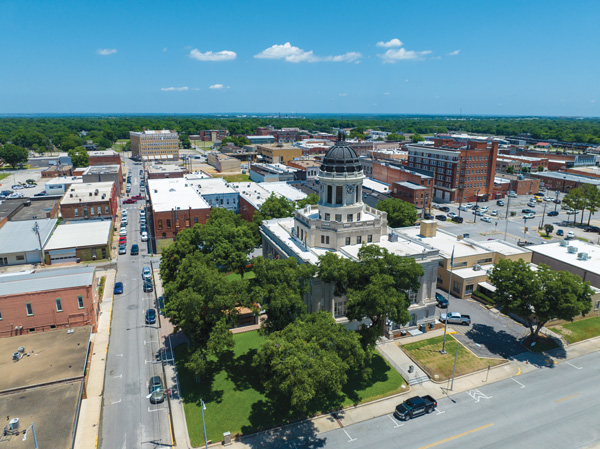Throughout the U.S. for generations, hydrogen has anchored its role for industrial use within oil refining, steel production, food processing and ammonia production, among other applications. Outside of top hydrogen producing states such as California, Louisiana and Texas, the element will soon promote new opportunity in the southern Oklahoma city of Ardmore.
Ardmore’s earliest days were marked by a thriving agricultural industry, due in part to the introduction of the former Atchison, Topeka and Santa Fe Railroad in the late 1800s. The discovery of oil deposits in 1905 allowed the burgeoning city to adopt a new industry focused on oil refining. In the 111 years the Valero Ardmore Refinery has been in operation, Ardmore has proved to know a thing or two about sustainably producing a variety of petroleum products.
Oklahoma itself has become the sixth-largest producer of natural gas and crude oil, while producing three times the amount of energy it consumes, according to the U.S. Energy Information Administration. The Valero Ardmore Refinery has become a key player in this region of the state for production of clean-burning fuels. Modernization initiatives since Valero’s acquisition in 2001 have allowed the site to process heavier sour crudes while maintaining high product yields.
“Our people know and understand energy and its role in every aspect of the economy better than anywhere else,” says Ardmore Development Authority Vice President of Economic Development Andrea Anderson.
For corporate leaders focused on driving sustainable operations, Ardmore is becoming an ideal destination to explore transformative projects.
Making Way for H2OK
Three years ago, Australia-based petroleum exploration and production company Woodside Energy made the decision to invest in its first U.S. liquid hydrogen facility, choosing to locate in the city of Ardmore.
The company purchased approximately 90 acres at the Westport Industrial Park, noting its highway access, supply chain infrastructure and proximity to supply potential customers as key factors in this move. Named H2OK, the project is expected to produce 60 tons per day (tpd) of liquid hydrogen once operational.
The company is in the midst of finalizing state incentives in support of the project before making its final investment announcement. Woodside completed its Front End Engineering and Design for H2OK in 2022, later awarding Nel Hydrogen a contract for engineering and fabrication of electrolysis equipment and a contract to Air Liquide to install two 30-tpd liquefaction units on the site. Once construction begins, Woodside has said the project has the potential to create a number of direct and indirect jobs.
“Many of the skills used in existing energy production are similar enough to the skills needed in hydrogen production that the learning curve is relatively short in making that transition,” says Anderson. “People working in other sectors of energy production see H2OK as the evolution of energy production.”
The H2OK electrolysis process will use a large portion of renewable energy to separate hydrogen from recycled wastewater. The company anticipates the facility will need about 200 megawatts of power from the Oklahoma Gas and Electric Grid for its operations. If utilizing power produced by renewable sources like wind and solar, which make up 7% of the grid’s portfolio, H2OK could run on close to zero emissions.
“As one of the first and largest facilities under design in the U.S., H2OK shows that Ardmore can play big and think outside the box,” says Anderson.
Enhancing a Clean Future
Woodside isn’t the only company looking to cultivate a sustainable way forward from the heart of Ardmore.
In June 2024, leading materials science company Dow announced it would be acquiring California-based renewable plastics recycler Circulus’ Oklahoma and Alabama facilities. Circulus launched its Ardmore operations in 2022, transforming post-consumer flexible plastics (like shrink film or plastic bags) made from low-density polyethylene resin into high-quality recycled resins that can be reused for consumer packaging.
 Ardmore is home to over 24,800 residents and centrally located about 90 miles between the Oklahoma City and Dallas, Texas metros.
Ardmore is home to over 24,800 residents and centrally located about 90 miles between the Oklahoma City and Dallas, Texas metros.
Photo courtesy of the Ardmore Development Authority
At the time Circulus arrived in Ardmore the company was just starting out and aiming to break into the greater market. Operations in the city over the course of two years showed a leading multinational corporation like Dow that not only did their technology work, but its impact has widespread benefits.
“This acquisition will allow Dow to combine our company’s industry-leading materials science technology with Circulus’ film recycling expertise to accelerate progress towards our 2030 Transform the Waste goal,” said Dow Packaging & Specialty Plastics President Karen Carter. “It will also expand how we participate in the industry, allowing us to generate value for our customers by directly producing more higher-performing circular products that brands and consumers are demanding.”
Ardmore’s operations will allow Dow to expand its reach in industrial, commercial and transportation markets. In utilizing Circulus’ technology, Dow aims to boost its product offerings for collation shrink packaging, stretch film, liners and select food packaging.
A combined 50,000 metric tons per year capacity between the two facilities will go a long way in supporting Dow’s 2030 Transform the Waste goal, which includes commercialization of 3 million metric tons of circular and renewable solutions per year.
“With Ardmore being their primary location, I see nothing but opportunity for the community as Circulus expands its operations,” says Anderson. “Being able to add the Dow name to the list of major employers in Ardmore also shows other industry leaders that there are good things happening in South Central Oklahoma.”
Throughout Ardmore’s history, its success has been dependent on leaders who are willing to take a chance on new technology and innovative ideas. This acceptance has carried on for generations, building upon existing industry and cultivating a knowledgeable workforce base.
“We try to find ways to get to ‘yes’ on every project we do, big or small. Our ultimate goal is to have an economically diverse and successful community,” says Anderson. “We know that only happens when our business and industry community are thriving.”
This Site Selection Investment Profile was produced under the auspices of Ardmore Development Authority. For more information, visit www.ardmoredevelopment.com.

